What is Marburg Virus? Outbreak In Equatorial Guinea Claims 9 Lives
KEY POINTS
- There are more than a dozen more suspected cases
- Health authorities have already deployed experts to the country
- Marburg virus is in the same family as Ebola
Nine people have died in a Marburg virus outbreak in Equatorial Guinea. What do people need to know about this "rare but severe" disease?
Equatorial Guinea confirmed the outbreak Monday, the World Health Organization (WHO) Africa noted in a news release. This comes after the deaths of nine people in Kie Ntem Province in western Equatorial Guinea, with some of the test sample results turning out to be positive for the virus.
The deaths reportedly occurred between Jan. 7 and Feb. 7, according to the United Nations (UN). So far, there are 16 other suspected cases of the illness. Some symptoms noted include fatigue, fever and blood-stained diarrhea and vomit.
It is the country's first-ever Marburg virus disease (MVD) outbreak.
Today, #EquatorialGuinea 🇬🇶 confirmed its first-ever outbreak of #Marburg virus. Preliminary tests carried out following the deaths of at least 9 people in the country’s western Kie Ntem Province turned out positive for the viral haemorrhagic fever 👉🏿 https://t.co/bcsL4Iusaz pic.twitter.com/sIbiLlNHW6
— WHO African Region (@WHOAFRO) February 13, 2023
The WHO deployed experts to the country following the confirmation of the outbreak, the UN noted. It also held an "urgent" emergency meeting Tuesday to discuss the outbreak as well as the available therapeutics and vaccines.
"Marburg is highly infectious," Dr. Matshidiso Moeti, WHO regional director for Africa, said in the WHO Africa release. "Thanks to the rapid and decisive action by the Equatorial Guinean authorities in confirming the disease, emergency response can get to full steam quickly so that we save lives and halt the virus as soon as possible."
What Is Marburg Virus Disease?
It is a "rare but severe" hemorrhagic fever that can affect both humans and non-human primates, the U.S. Centers for Disease Control and Prevention (CDC) explained. First recognized in 1967 amid simultaneous outbreaks in cities including Marburg and Belgrade, it is caused by the Marburg virus, which is an RNA virus in the filovirus family.
In fact, it was the first filovirus to be discovered. The "only" other known members in the family are said to be the six Ebola virus species.
MVD is not an airborne disease, the European Center for Disease Prevention and Control (ECDC) clarified. Instead, it is said to be transmitted from person to person via contact with the bodily fluids of a person who is sick with it or with objects and surfaces that are contaminated with the virus.
A "sudden" onset of symptoms may then occur after the incubation period of two to 21 days. These include chills, fever and headache. Around five days after symptoms onset, rashes tend to appear, more prominently on the trunk of the body, then other symptoms including diarrhea and abdominal pain may occur.
These may then progress to be increasingly severe, potentially leading to serious impacts such as "massive hemorrhaging and multi-organ dysfunction."
While MVD is rare, it is said to have the potential to cause epidemics with "significant case fatality rates." This is because it has a fatality ratio that can be as high as 88%.
So far, there is no treatment or vaccine for the Marburg virus, but merely supportive care to treat its symptoms.

© Copyright IBTimes 2024. All rights reserved.





















